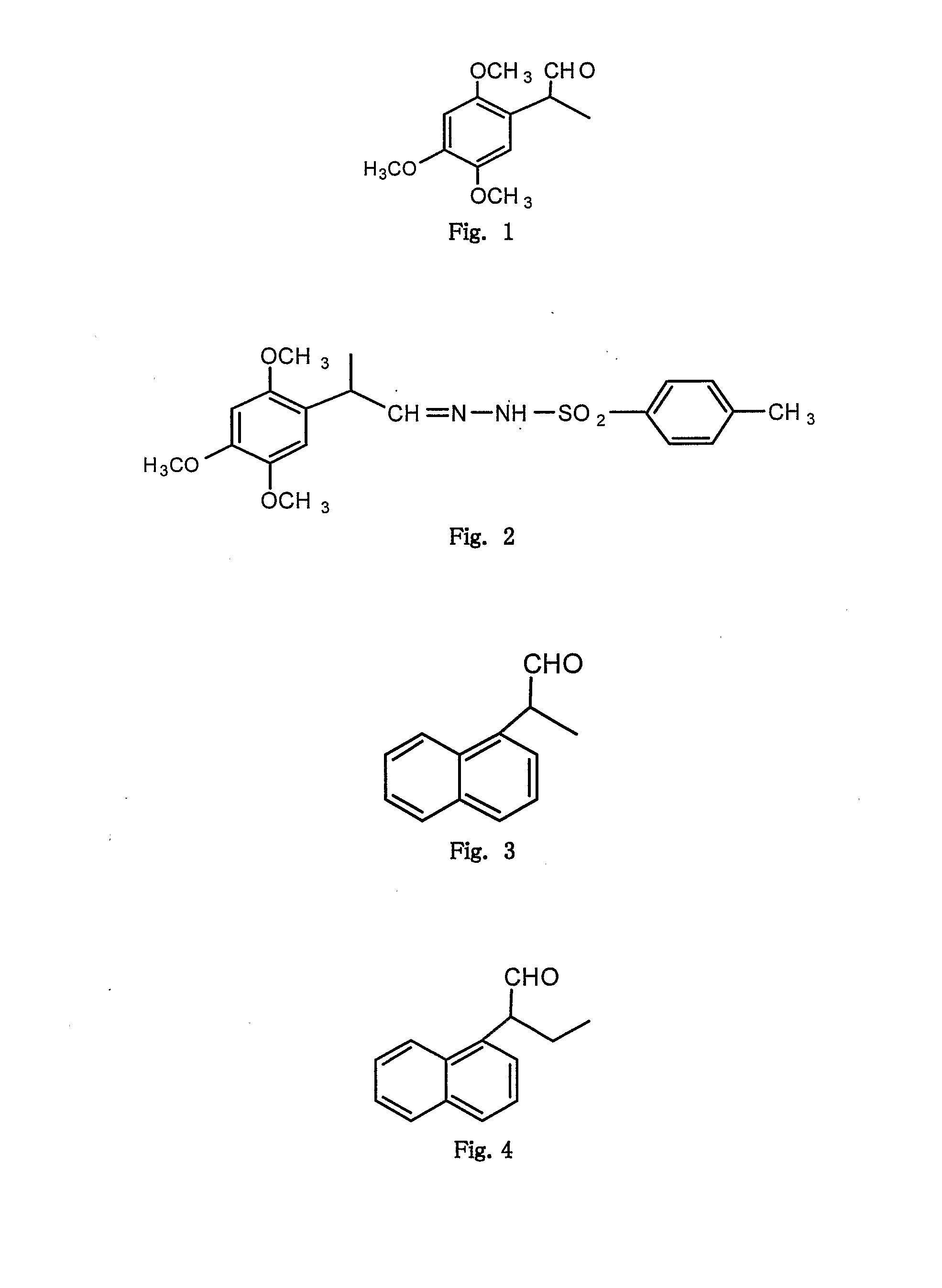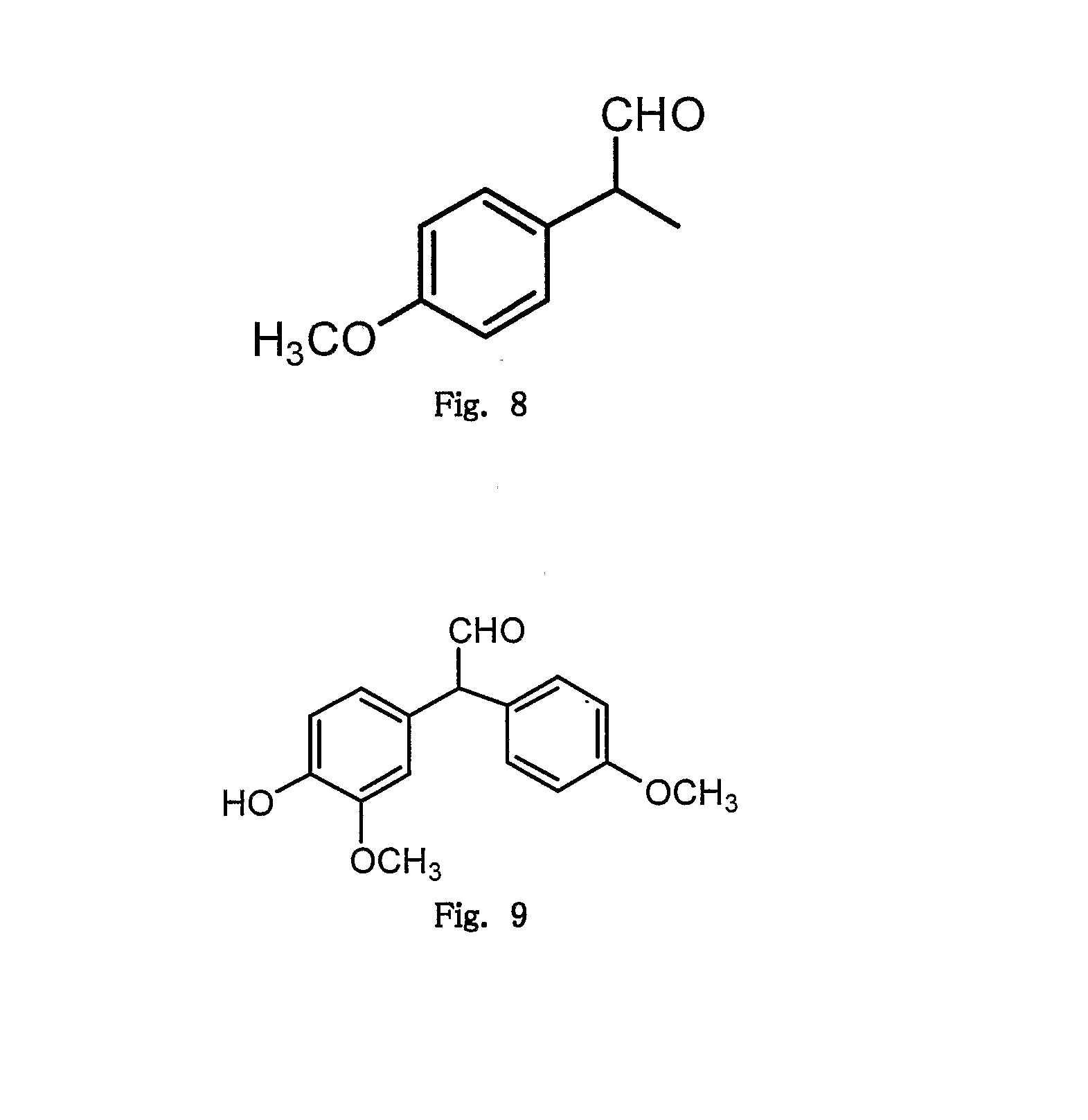Microwave induced single step green synthesis of some novel 2-aryl aldehydes and their analogues
- Summary
- Abstract
- Description
- Claims
- Application Information
AI Technical Summary
Benefits of technology
Problems solved by technology
Method used
Image
Examples
example i
Synthesis of 2-(2,4,5 trimethoxy phenyl)propionaldehyde
[0059](from formula I where R1, R3, R4═OMe, R2, R5═H, R′═CH3 and X═O): FIG. 1
[0060]A mixture of 2,4,5 trimethoxy phenyl propene (1 mmol), N-bromosuccinimide (1.5 mmol), water (12 ml), DMSO (3 ml), cetyltrimethyl ammonium bromide (0.3 mmol) were taken in a 100 ml round bottom flask fitted with a condenser. The flask was shaken well and placed inside the monomode microwave oven and irradiated (220 W, 200° C.) for 12 minutes in parts. The cooled mixture was poured into ice-cold water and extracted with ethyl acetate. The organic layer was washed with aq. sodium thiosulphate, brine and then organic layer dried over anhydrous sodium sulphate. The solvent was evaporated under reduced pressure to obtain a liquid which was purified on silica gel by column chromatography using a mixture of hexane and ethyl acetate (9:1 to 6:4), provided white viscous liquid; 60% yield; 1H NMR (CDCl3) δ 9.56 (1H, s), 6.55 (1H,$), 6.49 (1H, s), 3.82 (3H, s...
example ii
Synthesis of 2-(2,4,5 trimethoxy phenyl)propionaldehyde tosyl hydrazone
[0061](from formula I where R1, R3, R4 ═OMe, R2, R5═H, R′═CH3 and X═N—NH—SO2—C6H4—CH3) FIG. 2
[0062]The structure of above obtained 2-(2,4,5 trimethoxy phenyl)propionaldehyde (example 1) was further confirmed when the treatment of above aldehyde (1 mmol) with p-toluenesulphonyl hydrazide (1 mmol) in methanol as a solvent provided the corresponding hydrazone derivative (2-(2,4,5 trimethoxy phenyl)propionaldehyde tosyl hydrazone) in 60% yield; white solid m.p (150-151° C.), 1H NMR (CDCl3) δ 9.63 (1H, s), 7.79 (2H, d), 7.42 (2H, d), 6.67 (1H, s), 6.50 (1H, s), 3.92 (1H, q), 3.85 (3H, s), 3.74 (3H, s), 3.61 (3H, s), 2.38 (3H, s), 1.2 (3H, d) dc (75.4 MHz, CDCl3) 154.6, 152.0, 149.8, 144.2-137.3, 130.0, 128.4, 122.4, 113.9, 99.5, 56.9, 56.6, 56.2, 36.3, 21.2 and 17.6.
example iii
Synthesis of 2-(2,4,5 trimethoxy phenyl)propionaldehyde
[0063](from formula I where R1, R3, R4═OMe, R2, R5═H, R′═CH3 and X═O): FIG. 1
[0064]A mixture of 2,4,5 trimethoxy phenyl propene (1 mmol), N-bromosuccinimide (1.5 mmol), water (12 ml), DMSO (3 ml), cetyltrimethyl ammonium bromide (0.3 mmol) was taken in a 100 ml Erlenmeyer flask fitted with loose funnel at the top. The flask was shaken well and placed inside the multimode microwave oven and irradiated (900 W) for 8 minutes in parts. After completion of reaction, the reaction mixture was worked up as in example-1 to provide the corresponding 2-(2,4,5 trimethoxy phenyl)propionaldehyde (45% yield) whose spectral data matched with that mentioned in example-1.
PUM
| Property | Measurement | Unit |
|---|---|---|
| Temperature | aaaaa | aaaaa |
| Time | aaaaa | aaaaa |
| Power | aaaaa | aaaaa |
Abstract
Description
Claims
Application Information
 Login to View More
Login to View More - R&D
- Intellectual Property
- Life Sciences
- Materials
- Tech Scout
- Unparalleled Data Quality
- Higher Quality Content
- 60% Fewer Hallucinations
Browse by: Latest US Patents, China's latest patents, Technical Efficacy Thesaurus, Application Domain, Technology Topic, Popular Technical Reports.
© 2025 PatSnap. All rights reserved.Legal|Privacy policy|Modern Slavery Act Transparency Statement|Sitemap|About US| Contact US: help@patsnap.com



